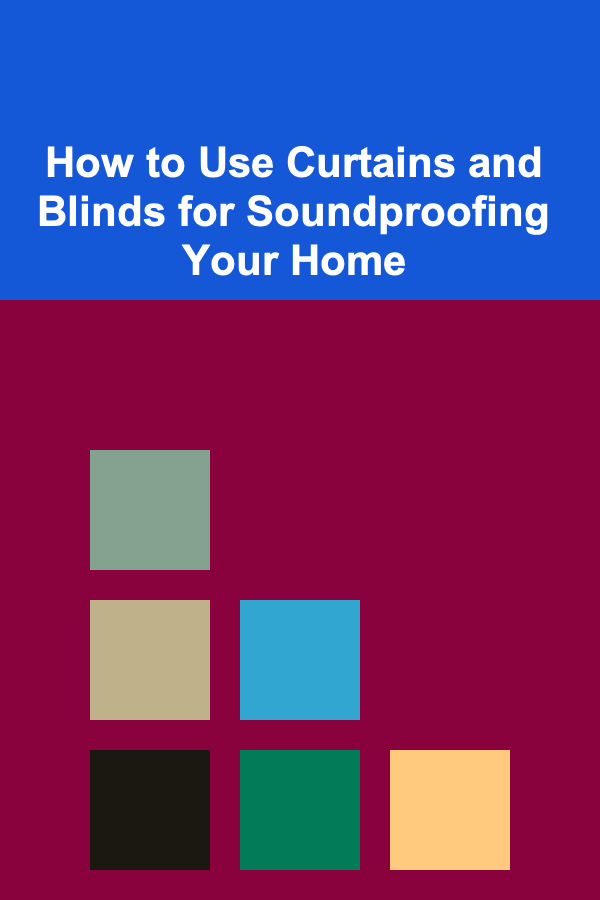
How to Use Curtains and Blinds for Soundproofing Your Home
ebook include PDF & Audio bundle (Micro Guide)
$12.99$11.99
Limited Time Offer! Order within the next:

Soundproofing your home can seem like a daunting task, especially when you're trying to achieve a peaceful environment without investing in expensive materials or professional services. One of the most affordable, practical, and aesthetic methods of reducing noise in your home is through the use of curtains and blinds. Not only do they serve their traditional purpose of privacy and light control, but with the right type, they can also significantly reduce noise transmission.
This article delves deep into how curtains and blinds can be effectively used to soundproof your home, exploring the science behind soundproofing, the different types of curtains and blinds that work best, and how you can optimize them for maximum noise reduction.
Understanding Soundproofing and Noise Control
Before we dive into specific products and strategies, it's important to first understand the basic principles of soundproofing. Sound travels through air as waves that are picked up by our ears, which then translate the vibrations into the sounds we hear. Noise control, including soundproofing, focuses on either blocking, absorbing, or redirecting sound waves to reduce their impact on your living space.
There are three main ways to address sound:
- Absorption: Absorbing sound waves to prevent them from bouncing back into the room.
- Blocking: Creating barriers that prevent sound from entering or leaving a room.
- Damping: Reducing the energy of sound waves as they pass through structural elements like walls, ceilings, and floors.
Curtains and blinds primarily help with absorption and blocking of sound. They absorb sound energy from external noise and prevent the sound from traveling into the room. When used correctly, curtains and blinds can reduce noise levels by a significant amount, especially when combined with other soundproofing measures.
How Curtains and Blinds Work for Soundproofing
Curtains and blinds help with soundproofing in a couple of important ways. Let's break down the mechanisms that allow them to reduce sound effectively.
Absorbing Sound Waves
Thick, dense fabrics have the ability to absorb sound waves. When sound waves hit a surface, they either pass through it or get reflected back into the room. The more porous and dense the material, the better it can absorb the sound. Thick, heavy curtains made of materials like velvet, wool, or specially designed acoustic fabrics can absorb sound waves, reducing the amount of noise that enters the room from the outside.
Blocking Sound Transmission
While most curtains and blinds are not designed to block sound completely, certain materials can provide a significant reduction in sound transmission. This is achieved by creating a barrier that makes it harder for sound to pass through. Heavy, multi-layered curtains are particularly effective at creating barriers that impede the travel of sound waves from outside or between rooms.
Creating Air Gaps
In addition to absorbing and blocking sound, curtains and blinds also help by creating an air gap between the window and the room. This air gap can serve as an additional layer of insulation, reducing the amount of sound that passes through the window. In soundproofing, this principle is similar to how double-paned windows work---by trapping air between two layers of glass, they help prevent sound transmission.
Types of Curtains and Blinds for Soundproofing
Now that we understand the basic principles, let's take a look at the different types of curtains and blinds that are most effective for soundproofing.
1. Heavy or Thick Curtains
One of the most effective ways to use curtains for soundproofing is to choose those made from heavy, dense fabrics. These curtains work by absorbing sound energy and preventing it from traveling into the room. The thicker the fabric, the better it is at blocking sound.
Best Fabrics for Soundproofing Curtains:
- Velvet: Velvet is a luxurious fabric known for its heavy texture, which helps absorb sound waves effectively.
- Wool: Wool is a dense and natural material that not only absorbs sound but also helps with insulation and temperature control.
- Cotton Canvas: While not as effective as velvet or wool, cotton canvas is still a relatively thick fabric that can help with sound absorption.
- Thermal Insulated Fabrics: Some curtains are made with a combination of sound-absorbing fabrics and an additional thermal layer to improve their effectiveness. These can significantly reduce noise and also help with energy efficiency.
The more layers of fabric in a curtain, the more effective it will be at reducing noise. Some manufacturers offer multi-layered curtains that are specifically designed for soundproofing.
2. Acoustic Curtains
Acoustic curtains are specialized soundproofing curtains designed to reduce noise. They are made of materials specifically engineered to absorb sound and block out external noise. These curtains are often lined with thick foam, fiberglass, or mass-loaded vinyl (MLV), which is a dense material that helps to block sound.
Features of Acoustic Curtains:
- Lined with Soundproofing Materials: Acoustic curtains are often lined with heavy, noise-dampening materials like mass-loaded vinyl (MLV) or foam to enhance their soundproofing properties.
- Thicker and Heavier: These curtains are typically much thicker than regular curtains and weigh more due to the soundproofing materials used.
- Noise Reduction: Acoustic curtains can reduce noise by as much as 50% or more, depending on the material and thickness.
Although acoustic curtains are specifically designed for soundproofing, they tend to be more expensive than regular curtains. However, they offer a significant advantage when noise reduction is a priority.
3. Double or Triple Layered Curtains
Another strategy for improving the soundproofing ability of curtains is to use double or triple-layered curtains. These curtains consist of multiple layers of fabric, which work together to absorb sound and create a thicker barrier.
How Multi-Layered Curtains Work:
- Absorption: The different layers of fabric absorb sound at various frequencies, reducing the amount of sound that enters the room.
- Blockage: The multiple layers help to block sound from passing through the window, effectively creating a barrier against noise.
- Air Gap: Between the layers of fabric, there can be small air gaps that further help to insulate the room from sound.
Double and triple-layered curtains are particularly effective when combined with heavy fabrics like velvet or wool, as they offer both absorption and sound-blocking properties.
4. Blinds with Soundproofing Features
While curtains are the most commonly used window treatments for soundproofing, certain types of blinds can also be effective. Blinds typically don't offer the same level of sound absorption as curtains, but they can still play a role in reducing noise.
Types of Blinds for Soundproofing:
- Cellular or Honeycomb Blinds: Cellular blinds, also known as honeycomb blinds, feature an innovative design that traps air in the honeycomb structure. This air gap helps to insulate the room and reduce sound transmission.
- Thick Roller Blinds: Roller blinds made from thick, dense materials can also provide some degree of soundproofing by blocking out noise. While they may not be as effective as heavy curtains, they are a more affordable option.
- Roman Blinds: Roman blinds are typically made from thicker fabrics and can provide some level of sound reduction, especially when made from materials like velvet or wool.
While blinds may not be as effective as curtains for soundproofing, they can still help create a more peaceful environment, particularly when combined with other soundproofing measures.
How to Optimize Curtains and Blinds for Maximum Soundproofing
To get the most out of your curtains and blinds in terms of soundproofing, there are several additional strategies you can employ.
1. Ensure Full Coverage
For your curtains or blinds to be effective at soundproofing, they need to cover the entire window. Sound can leak through the edges of the window, so make sure the curtains or blinds are large enough to cover the entire surface. This includes ensuring the curtains reach from the top of the window to the floor, and from one side of the window to the other.
2. Install Curtain Tracks or Rods Close to the Wall
To prevent sound from seeping in around the edges, install your curtain tracks or rods as close to the wall as possible. This ensures that the curtains hang tightly against the window, minimizing gaps where sound can leak through.
3. Use Acoustic Curtain Linings
If you already have curtains that you like but want to improve their soundproofing ability, consider adding an acoustic lining to them. Acoustic linings are typically made of thick foam or mass-loaded vinyl and can be attached to the back of your existing curtains to enhance their noise-reducing properties.
4. Seal the Gaps Around the Window
Even the best curtains won't be fully effective if there are gaps around the window where sound can slip through. Use weatherstripping or acoustic caulk around the edges of the window frame to seal any gaps and create a more airtight seal.
5. Layer with Other Soundproofing Methods
For maximum soundproofing effectiveness, consider combining curtains and blinds with other soundproofing measures, such as wall hangings, acoustic panels, or even double-glazed windows. The more layers of soundproofing you add, the better the results will be.
Conclusion
Curtains and blinds are an affordable and effective way to reduce noise and improve the soundproofing of your home. By choosing the right materials, such as heavy fabrics, acoustic curtains, or cellular blinds, and optimizing their placement, you can create a quieter, more peaceful environment. While curtains and blinds may not block all external noise, they can make a significant difference in reducing sound levels, especially when combined with other soundproofing strategies.
Reading More From Our Other Websites
- [Personal Investment 101] How to Turn Deep Learning Models into a Continuous Revenue Stream
- [Personal Investment 101] Generate Passive Income with AI Models: A Deep Learning Approach
- [Organization Tip 101] How to Choose the Right Size Furniture for Your Space
- [Home Pet Care 101] How to Create a Pet-Friendly Cleaning Routine
- [Skydiving Tip 101] Choosing the Right Drop Zone: How to Find the Perfect Skydiving School Near You
- [Home Budget 101] How to Build an Affordable Home Office Budget
- [Home Maintenance 101] How to Winterize Your House: Essential Preparations
- [Home Budget Decorating 101] How to Create a DIY Chalkboard Wall for a Unique Home Feature
- [Personal Investment 101] How to Invest in Real Estate: Tips for Beginners
- [Horseback Riding Tip 101] Best Horseback Riding Therapy: The Healing Benefits of Connecting with Equine Partners

How to Offer Specialized Cleaning Services (e.g., Carpet, Upholstery)
Read More
How to Use Color Coding for Easy Tool Identification
Read More
How to Identify Juxtaposition in Film
Read More
Understanding Blockchain for Data Sharing: A Comprehensive Guide
Read More
How to Read a Company's Financial Report
Read More
10 Tips for Account Managers Working Remotely
Read MoreOther Products

How to Offer Specialized Cleaning Services (e.g., Carpet, Upholstery)
Read More
How to Use Color Coding for Easy Tool Identification
Read More
How to Identify Juxtaposition in Film
Read More
Understanding Blockchain for Data Sharing: A Comprehensive Guide
Read More
How to Read a Company's Financial Report
Read More